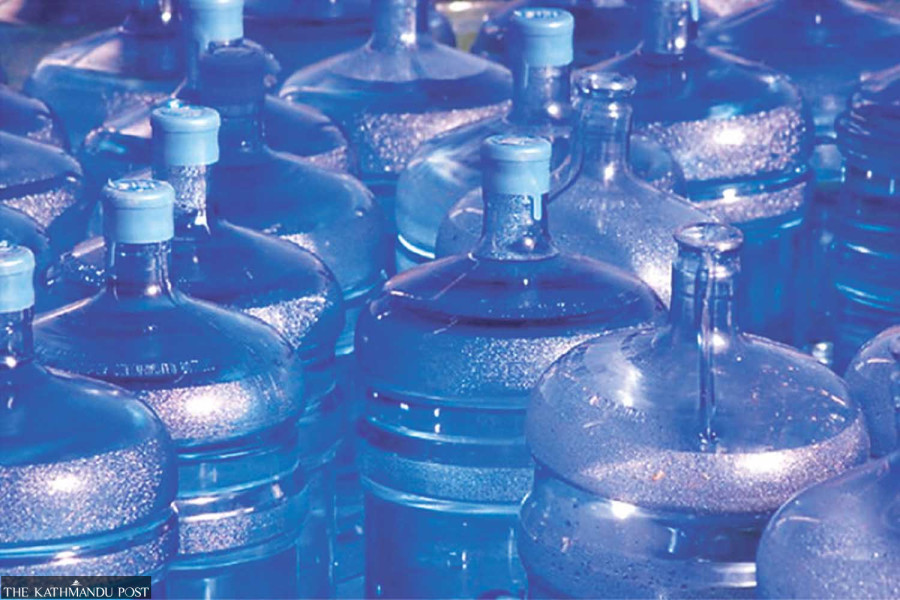Health
Every fourth drinking water sample in Kathmandu has faecal coliform
Most of the tested samples were taken from bottled water.
Arjun Poudel
Nearly a quarter of the drinking water being used in Kathmandu has been found contaminated with faecal coliform, according to the latest study carried out by the government’s Epidemiology and Disease Control Division.
Faecal coliform, a microscopic organism, lives in the intestines of warm-blooded animals or their faeces.
The presence of faecal coliform means that the drinking water being used by the residents of Kathmandu is contaminated with sewage, doctors say.
“Presence of faecal coliform has been found in 32.6 percent of the water samples collected from ward 13 of Kathmandu Metropolitan City in the third week of May,” Bhola Adhikari, an official at the division told the Post. “Most of the water samples collected for tests were from bottled jar water.”
Along with jar water, tests were carried out on tap water supplied by the state utility, tanker water, tube well water, water from wells, and Melamchi water.
Officials at the division said that water samples were also collected from wards 11 and 12 and deadly microbes were found in 16.7 and 15.5 percent of their samples, respectively.
The division had carried out a similar testing in the last week of April too. The drinking water samples collected then from the same places had also shown the presence of faecal coliform.
According to officials, faecal coliform was detected in 20.8 percent of the drinking water samples collected in April from ward 11; 13.9 percent in the samples from ward 12; and 18.5 percent in the samples from ward 13. Officials say, 504 water samples from various sources were tested back then.
Of the 504 water samples collected for testing in April, 271 were from jar water, and of them, 37 samples (13.7 percent) were contaminated with faecal coliform. Likewise, 152 were tap water samples and of them, 30 samples (19.7 percent) had harmful microbes. Similarly, 10 out of 28 well water samples (35.7 percent), four out of 25 Melamchi water samples (16 percent), seven out of 23 samples of tanker water (30.4 percent), and one rainwater sample were found contaminated with coliform.
Jar water is widely used by households and offices in the Kathmandu Valley and is considered comparatively safe. However, the presence of the deadly microbes suggests not all jar water brands are safe to drink, without treatment.
“The presence of faecal coliform in jar water shows that the water is contaminated with faeces,” said Dr Sher Bahadur Pun, chief of the Clinical Research Unit at Sukraraj Tropical and Infectious Disease Hospital. “We should not forget that cholera also spreads from faecal contamination of water.”
Experts have asked the general public to make sure their water is safe before drinking.
“Proper purification of drinking water, its safe storage and safe handling are as important,” said Merina Maharjan, programme officer of Environment and Public Health Organisation, a non-governmental entity. “Methods being used in water purification also determine the water quality.”
According to the study, no microbes were found in water that was filtered and boiled. Likewise, the chlorination method used for water purification was also found to be 100 percent safe.
Last year, the Kathmandu Valley witnessed a massive cholera outbreak as of those who were tested, at least 70 percent tested positive for Vibrio cholera 01 Ogawa serotype.
Cholera is a highly infectious disease that causes severe diarrhoea and vomiting, resulting in dehydration and can lead to death within hours, if left untreated.
Public health experts say the consumption of contaminated water not only causes cholera, but also increases the chances of contracting dysentery, typhoid, and hepatitis A and E.
Doctors say initiating awareness drives and ensuring safe drinking water are the only ways to save people from water-borne diseases, including cholera. A combination of careful surveys, provision of safe drinking water, good sanitation and hygiene standards, social mobilisation, and treatment are required to contain the spread of infection, they added.
The World Health Organisation says cholera is a global threat to public health and an indicator of inequality and lack of social development.
The UN health agency also said a multifaceted approach is required to control cholera and cut deaths.




 10.12°C Kathmandu
10.12°C Kathmandu














